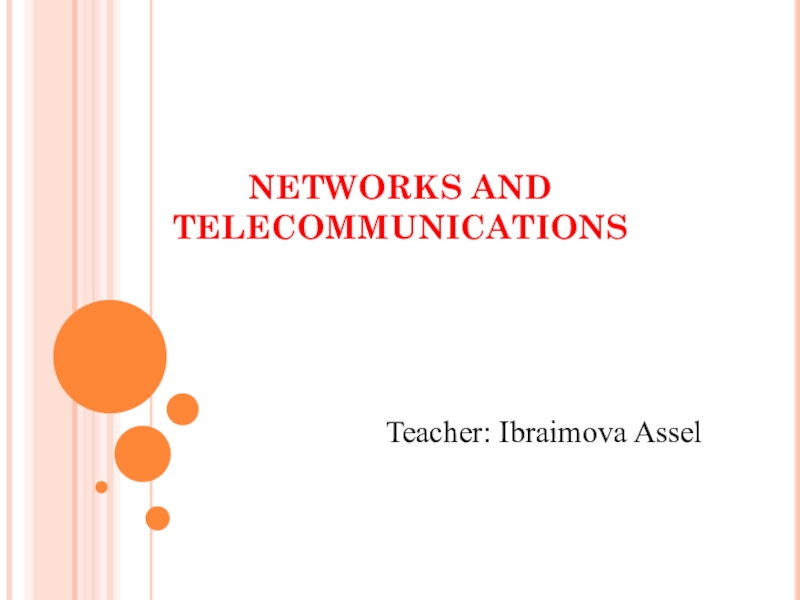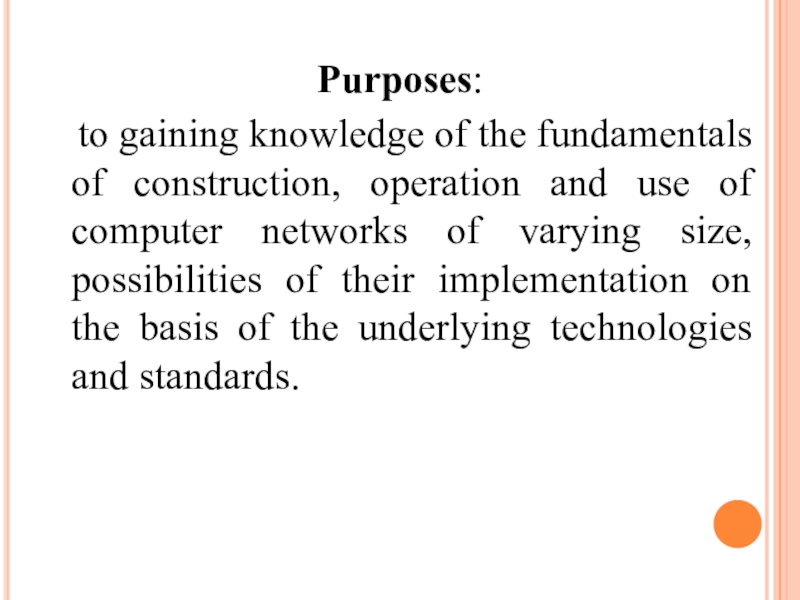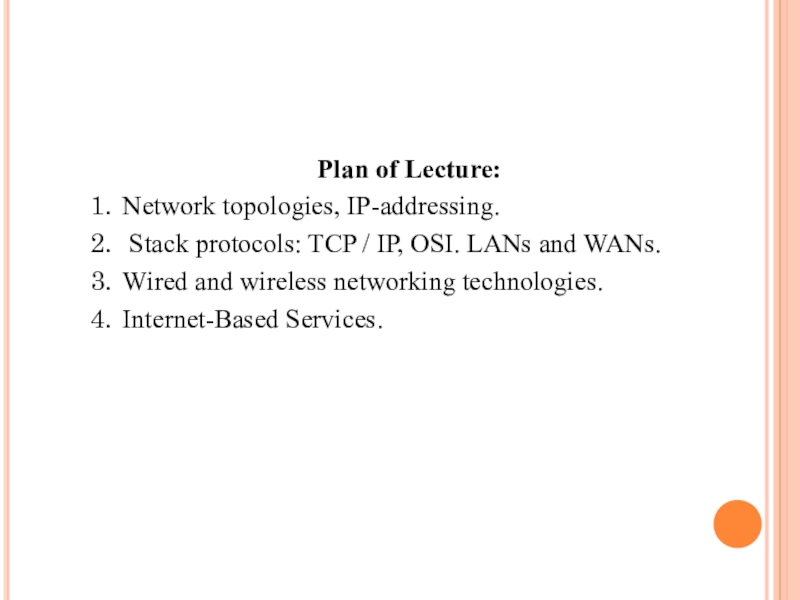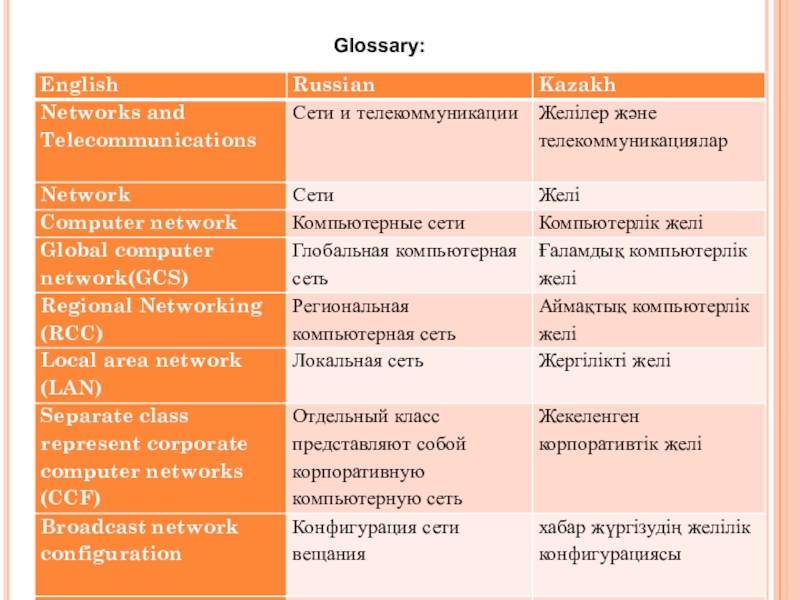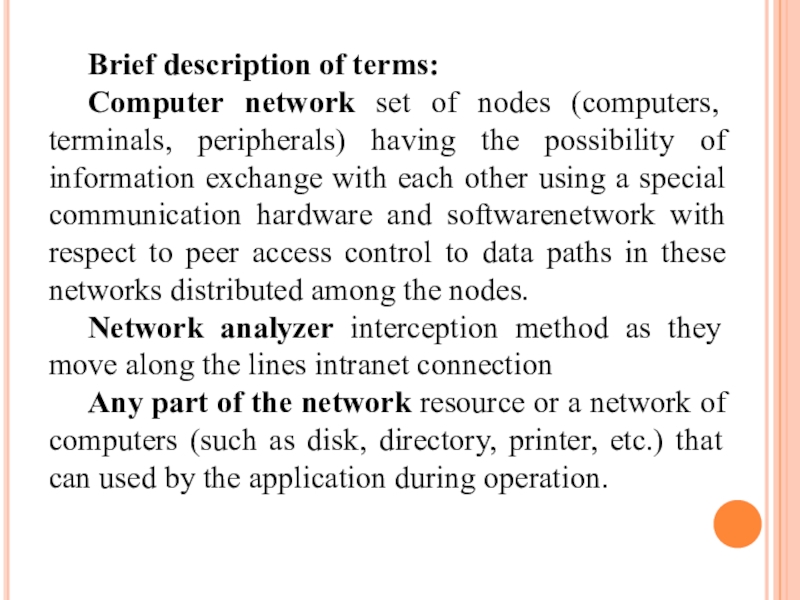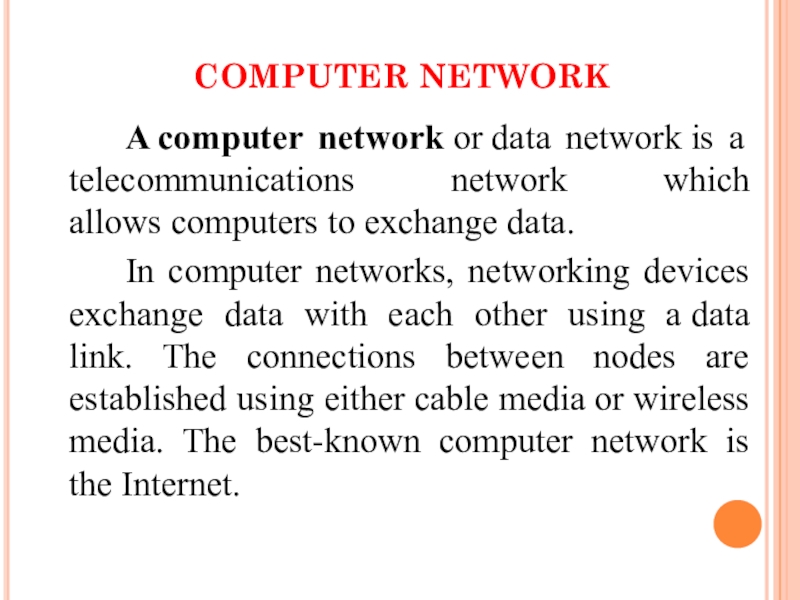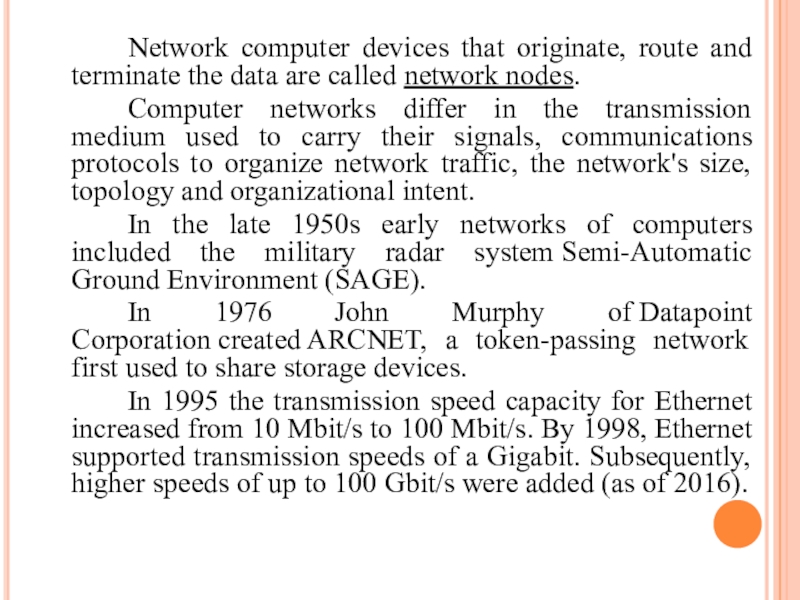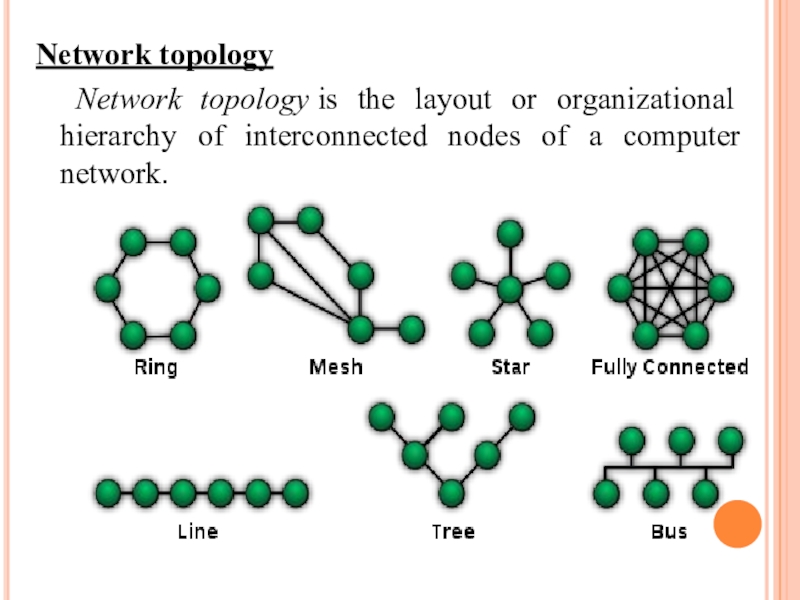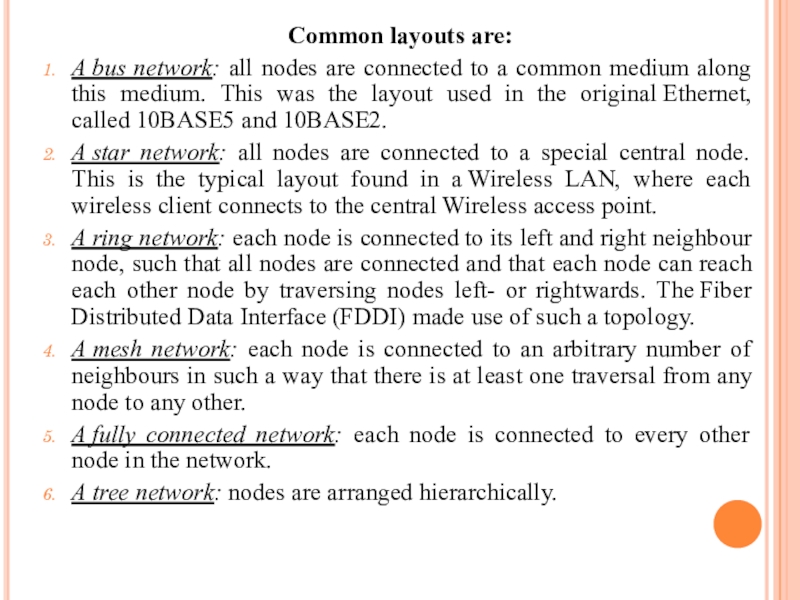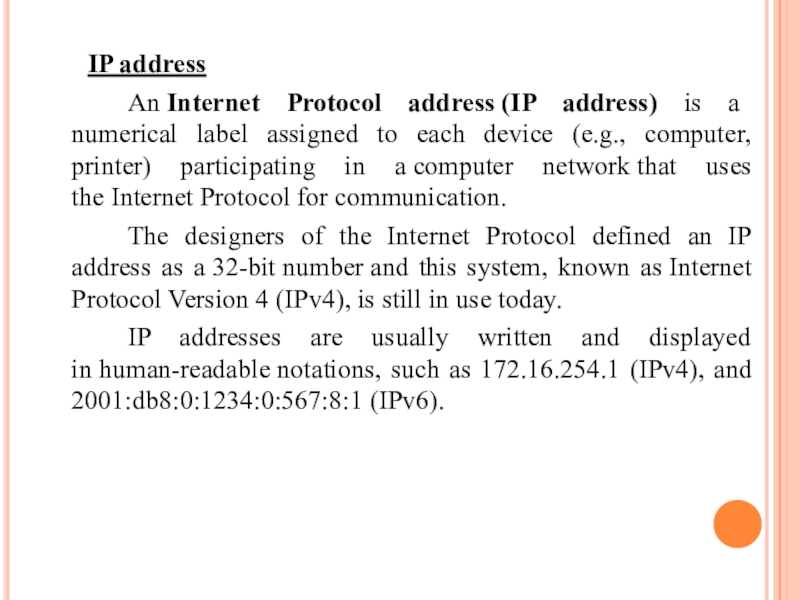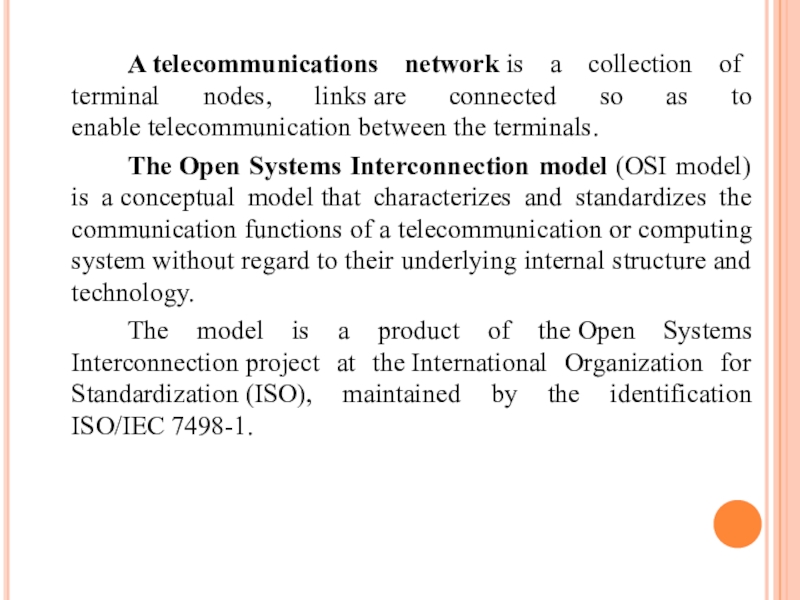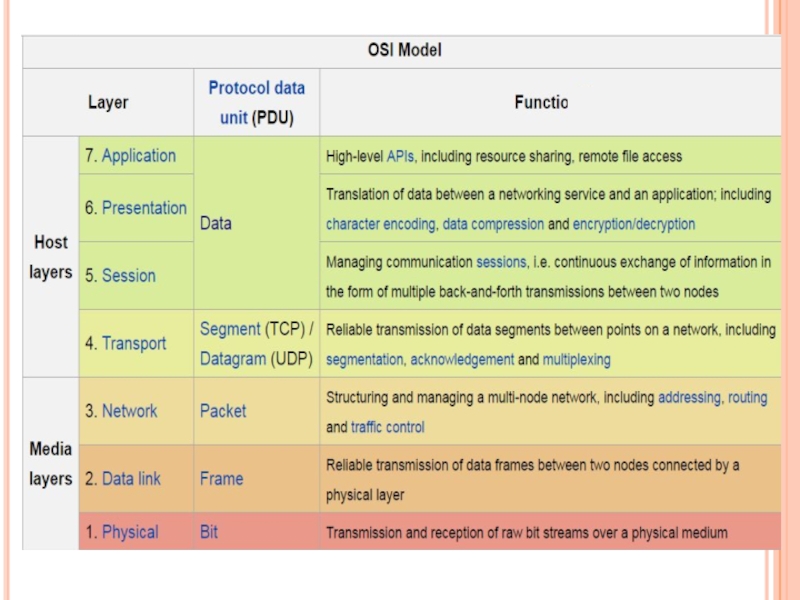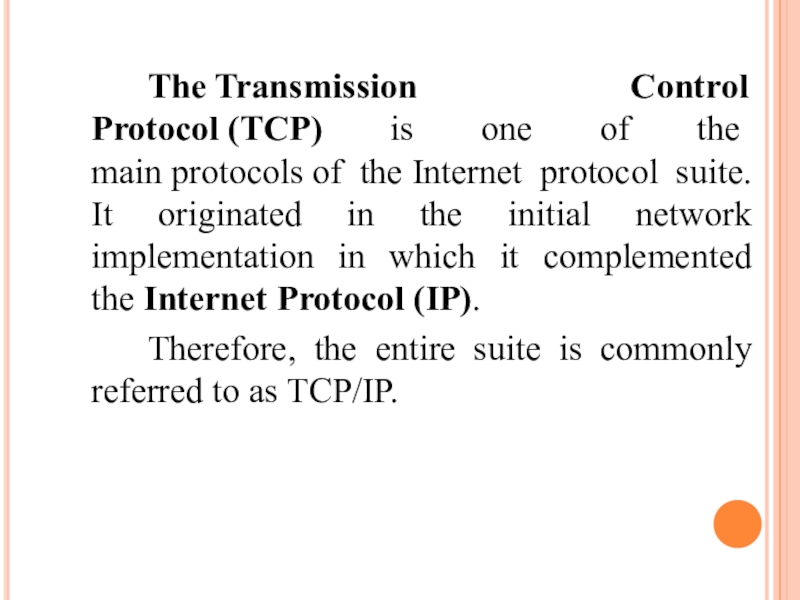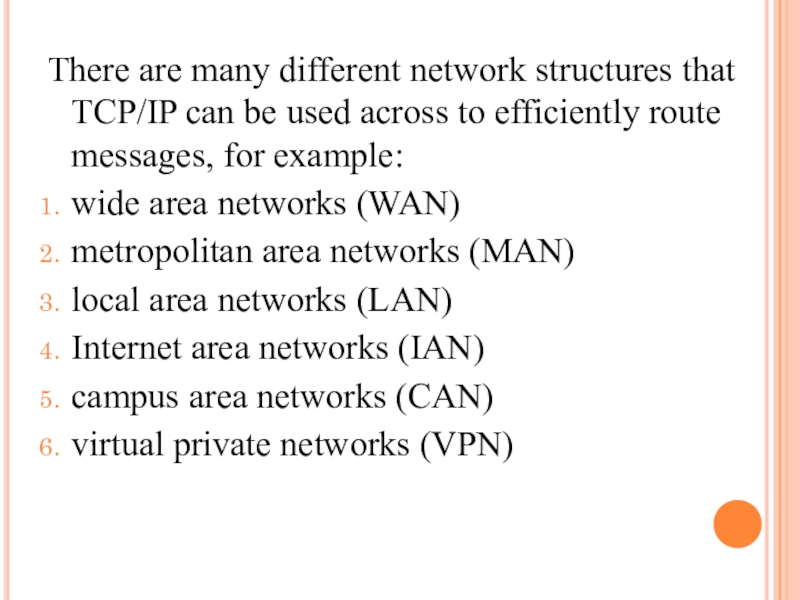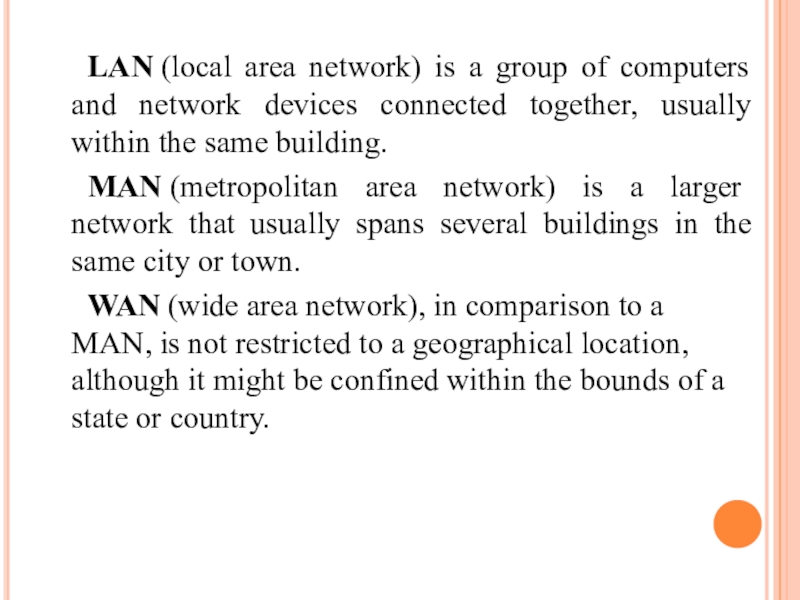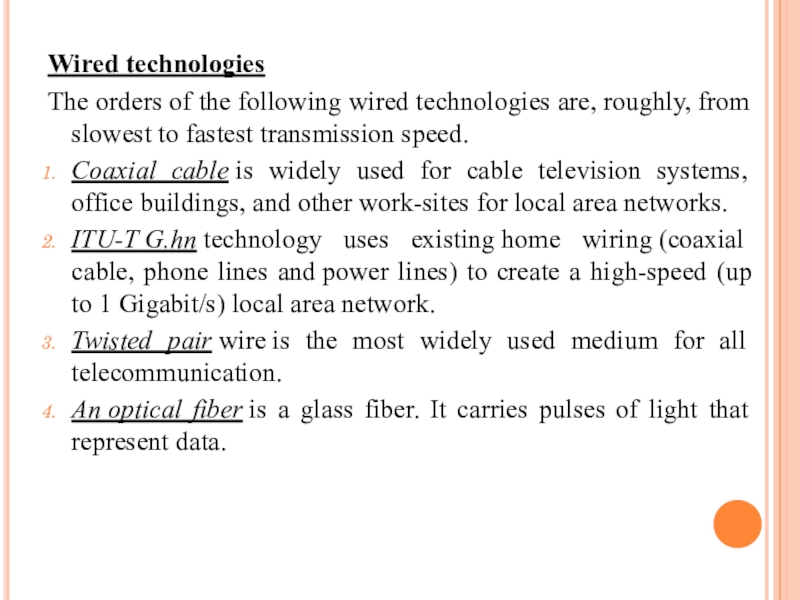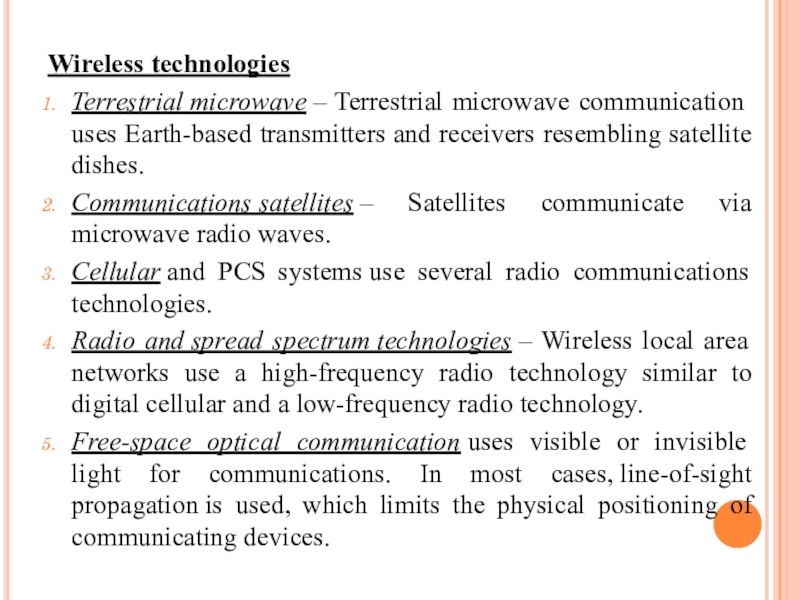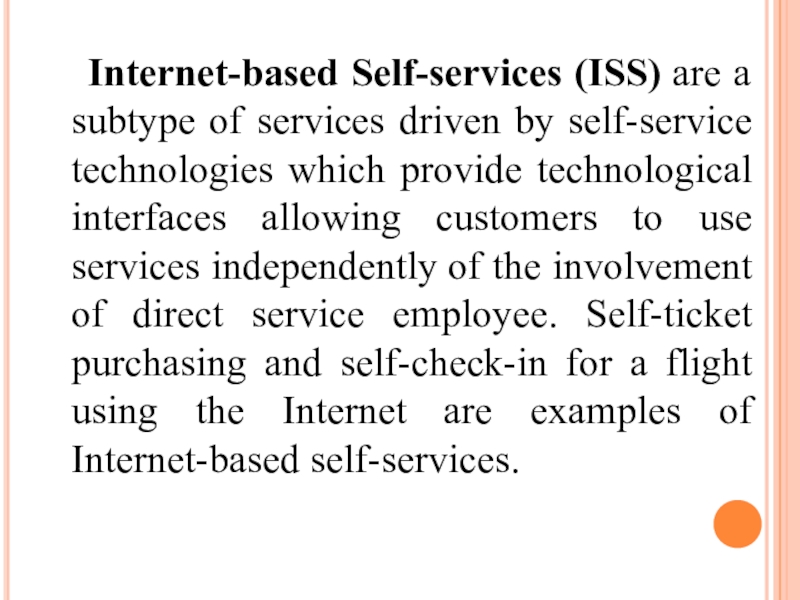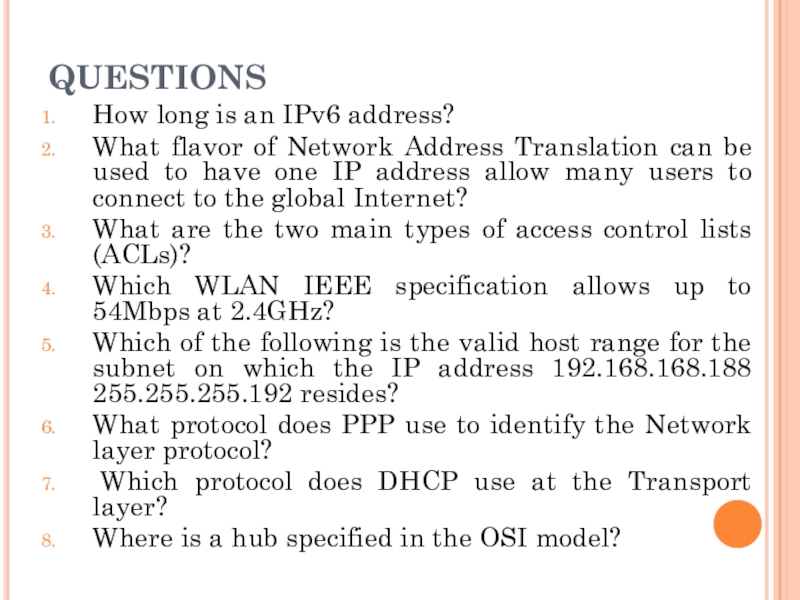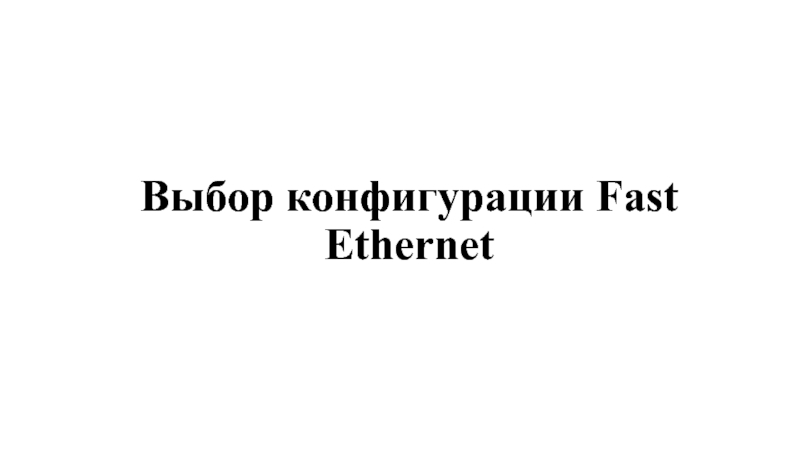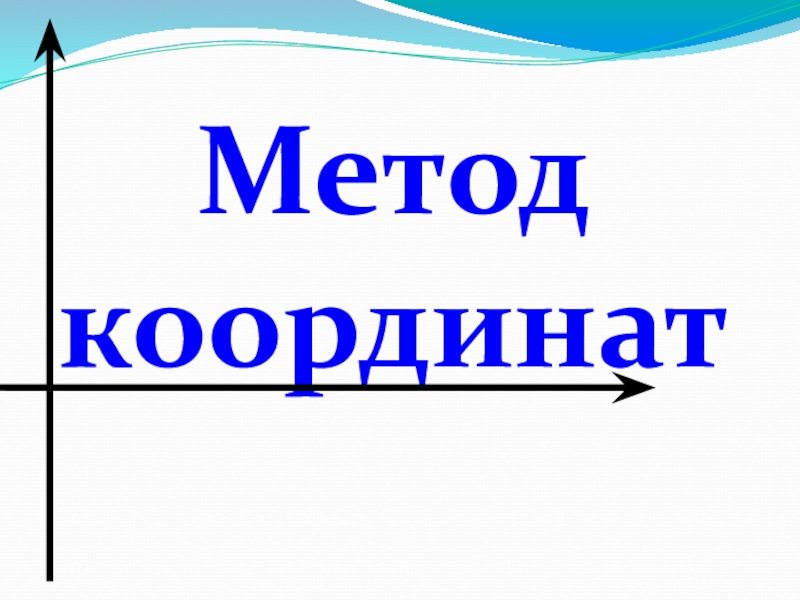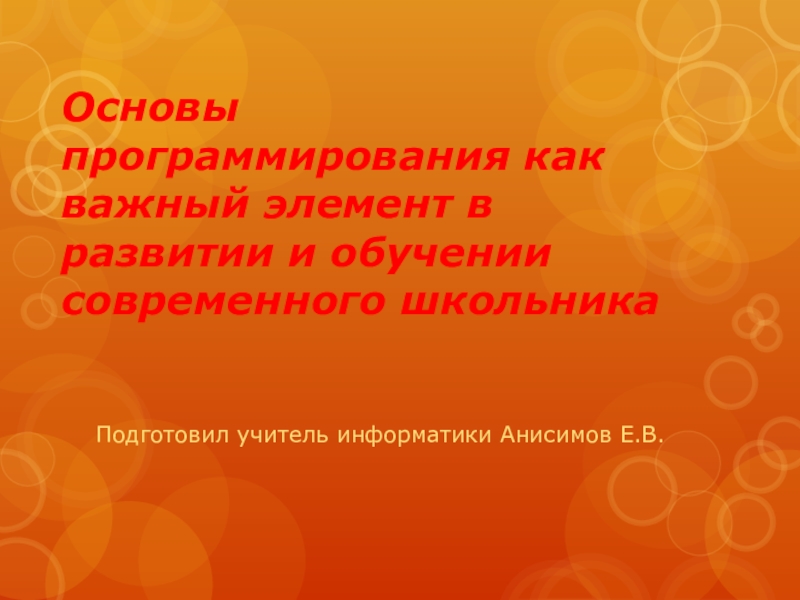- Главная
- Разное
- Образование
- Спорт
- Естествознание
- Природоведение
- Религиоведение
- Французский язык
- Черчение
- Английский язык
- Астрономия
- Алгебра
- Биология
- География
- Геометрия
- Детские презентации
- Информатика
- История
- Литература
- Математика
- Музыка
- МХК
- Немецкий язык
- ОБЖ
- Обществознание
- Окружающий мир
- Педагогика
- Русский язык
- Технология
- Физика
- Философия
- Химия
- Шаблоны, фоны, картинки для презентаций
- Экология
- Экономика
Презентация, доклад на тему Presentation on ICT Networks and telecommunications
Содержание
- 1. Presentation on ICT Networks and telecommunications
- 2. Purposes: to gaining knowledge of the
- 3. Plan of Lecture:Network topologies, IP-addressing. Stack protocols:
- 4. Glossary:
- 5. Brief description of terms:Computer network set of
- 6. COMPUTER NETWORK A computer network or data network is a telecommunications network
- 7. Network computer devices that originate, route and
- 8. Network topology Network topology is the layout or organizational hierarchy of interconnected nodes of a computer network.
- 9. Common layouts are:A bus network: all nodes are
- 10. IP address An Internet Protocol address (IP address) is a
- 11. A telecommunications network is a collection of terminal nodes,
- 12. Слайд 12
- 13. The Transmission Control Protocol (TCP) is one of the
- 14. There are many different network structures that
- 15. LAN (local area network) is a group of
- 16. Wired technologiesThe orders of the following wired
- 17. Wireless technologiesTerrestrial microwave – Terrestrial microwave communication uses Earth-based
- 18. Internet-based Self-services (ISS) are a subtype of services
- 19. QUESTIONSHow long is an IPv6 address?What flavor
- 20. Thanks for attention!
Purposes: to gaining knowledge of the fundamentals of construction, operation and use of computer networks of varying size, possibilities of their implementation on the basis of the underlying technologies and standards.
Слайд 2Purposes:
to gaining knowledge of the fundamentals of construction,
operation and use of computer networks of varying size, possibilities of their implementation on the basis of the underlying technologies and standards.
Слайд 3Plan of Lecture:
Network topologies, IP-addressing.
Stack protocols: TCP / IP, OSI.
LANs and WANs.
Wired and wireless networking technologies.
Internet-Based Services.
Wired and wireless networking technologies.
Internet-Based Services.
Слайд 5Brief description of terms:
Computer network set of nodes (computers, terminals, peripherals)
having the possibility of information exchange with each other using a special communication hardware and softwarenetwork with respect to peer access control to data paths in these networks distributed among the nodes.
Network analyzer interception method as they move along the lines intranet connection
Any part of the network resource or a network of computers (such as disk, directory, printer, etc.) that can used by the application during operation.
Network analyzer interception method as they move along the lines intranet connection
Any part of the network resource or a network of computers (such as disk, directory, printer, etc.) that can used by the application during operation.
Слайд 6COMPUTER NETWORK
A computer network or data network is a telecommunications network which allows computers to exchange data.
In
computer networks, networking devices exchange data with each other using a data link. The connections between nodes are established using either cable media or wireless media. The best-known computer network is the Internet.
Слайд 7 Network computer devices that originate, route and terminate the data are
called network nodes.
Computer networks differ in the transmission medium used to carry their signals, communications protocols to organize network traffic, the network's size, topology and organizational intent.
In the late 1950s early networks of computers included the military radar system Semi-Automatic Ground Environment (SAGE).
In 1976 John Murphy of Datapoint Corporation created ARCNET, a token-passing network first used to share storage devices.
In 1995 the transmission speed capacity for Ethernet increased from 10 Mbit/s to 100 Mbit/s. By 1998, Ethernet supported transmission speeds of a Gigabit. Subsequently, higher speeds of up to 100 Gbit/s were added (as of 2016).
Computer networks differ in the transmission medium used to carry their signals, communications protocols to organize network traffic, the network's size, topology and organizational intent.
In the late 1950s early networks of computers included the military radar system Semi-Automatic Ground Environment (SAGE).
In 1976 John Murphy of Datapoint Corporation created ARCNET, a token-passing network first used to share storage devices.
In 1995 the transmission speed capacity for Ethernet increased from 10 Mbit/s to 100 Mbit/s. By 1998, Ethernet supported transmission speeds of a Gigabit. Subsequently, higher speeds of up to 100 Gbit/s were added (as of 2016).
Слайд 8Network topology
Network topology is the layout or organizational hierarchy of interconnected nodes
of a computer network.
Слайд 9Common layouts are:
A bus network: all nodes are connected to a common
medium along this medium. This was the layout used in the original Ethernet, called 10BASE5 and 10BASE2.
A star network: all nodes are connected to a special central node. This is the typical layout found in a Wireless LAN, where each wireless client connects to the central Wireless access point.
A ring network: each node is connected to its left and right neighbour node, such that all nodes are connected and that each node can reach each other node by traversing nodes left- or rightwards. The Fiber Distributed Data Interface (FDDI) made use of such a topology.
A mesh network: each node is connected to an arbitrary number of neighbours in such a way that there is at least one traversal from any node to any other.
A fully connected network: each node is connected to every other node in the network.
A tree network: nodes are arranged hierarchically.
A star network: all nodes are connected to a special central node. This is the typical layout found in a Wireless LAN, where each wireless client connects to the central Wireless access point.
A ring network: each node is connected to its left and right neighbour node, such that all nodes are connected and that each node can reach each other node by traversing nodes left- or rightwards. The Fiber Distributed Data Interface (FDDI) made use of such a topology.
A mesh network: each node is connected to an arbitrary number of neighbours in such a way that there is at least one traversal from any node to any other.
A fully connected network: each node is connected to every other node in the network.
A tree network: nodes are arranged hierarchically.
Слайд 10 IP address
An Internet Protocol address (IP address) is a numerical label assigned to
each device (e.g., computer, printer) participating in a computer network that uses the Internet Protocol for communication.
The designers of the Internet Protocol defined an IP address as a 32-bit number and this system, known as Internet Protocol Version 4 (IPv4), is still in use today.
IP addresses are usually written and displayed in human-readable notations, such as 172.16.254.1 (IPv4), and 2001:db8:0:1234:0:567:8:1 (IPv6).
The designers of the Internet Protocol defined an IP address as a 32-bit number and this system, known as Internet Protocol Version 4 (IPv4), is still in use today.
IP addresses are usually written and displayed in human-readable notations, such as 172.16.254.1 (IPv4), and 2001:db8:0:1234:0:567:8:1 (IPv6).
Слайд 11 A telecommunications network is a collection of terminal nodes, links are connected so as
to enable telecommunication between the terminals.
The Open Systems Interconnection model (OSI model) is a conceptual model that characterizes and standardizes the communication functions of a telecommunication or computing system without regard to their underlying internal structure and technology.
The model is a product of the Open Systems Interconnection project at the International Organization for Standardization (ISO), maintained by the identification ISO/IEC 7498-1.
The Open Systems Interconnection model (OSI model) is a conceptual model that characterizes and standardizes the communication functions of a telecommunication or computing system without regard to their underlying internal structure and technology.
The model is a product of the Open Systems Interconnection project at the International Organization for Standardization (ISO), maintained by the identification ISO/IEC 7498-1.
Слайд 13 The Transmission Control Protocol (TCP) is one of the main protocols of the Internet protocol suite.
It originated in the initial network implementation in which it complemented the Internet Protocol (IP).
Therefore, the entire suite is commonly referred to as TCP/IP.
Therefore, the entire suite is commonly referred to as TCP/IP.
Слайд 14There are many different network structures that TCP/IP can be used
across to efficiently route messages, for example:
wide area networks (WAN)
metropolitan area networks (MAN)
local area networks (LAN)
Internet area networks (IAN)
campus area networks (CAN)
virtual private networks (VPN)
wide area networks (WAN)
metropolitan area networks (MAN)
local area networks (LAN)
Internet area networks (IAN)
campus area networks (CAN)
virtual private networks (VPN)
Слайд 15 LAN (local area network) is a group of computers and network devices
connected together, usually within the same building.
MAN (metropolitan area network) is a larger network that usually spans several buildings in the same city or town.
WAN (wide area network), in comparison to a MAN, is not restricted to a geographical location, although it might be confined within the bounds of a state or country.
MAN (metropolitan area network) is a larger network that usually spans several buildings in the same city or town.
WAN (wide area network), in comparison to a MAN, is not restricted to a geographical location, although it might be confined within the bounds of a state or country.
Слайд 16Wired technologies
The orders of the following wired technologies are, roughly, from
slowest to fastest transmission speed.
Coaxial cable is widely used for cable television systems, office buildings, and other work-sites for local area networks.
ITU-T G.hn technology uses existing home wiring (coaxial cable, phone lines and power lines) to create a high-speed (up to 1 Gigabit/s) local area network.
Twisted pair wire is the most widely used medium for all telecommunication.
An optical fiber is a glass fiber. It carries pulses of light that represent data.
Coaxial cable is widely used for cable television systems, office buildings, and other work-sites for local area networks.
ITU-T G.hn technology uses existing home wiring (coaxial cable, phone lines and power lines) to create a high-speed (up to 1 Gigabit/s) local area network.
Twisted pair wire is the most widely used medium for all telecommunication.
An optical fiber is a glass fiber. It carries pulses of light that represent data.
Слайд 17Wireless technologies
Terrestrial microwave – Terrestrial microwave communication uses Earth-based transmitters and receivers resembling
satellite dishes.
Communications satellites – Satellites communicate via microwave radio waves.
Cellular and PCS systems use several radio communications technologies.
Radio and spread spectrum technologies – Wireless local area networks use a high-frequency radio technology similar to digital cellular and a low-frequency radio technology.
Free-space optical communication uses visible or invisible light for communications. In most cases, line-of-sight propagation is used, which limits the physical positioning of communicating devices.
Communications satellites – Satellites communicate via microwave radio waves.
Cellular and PCS systems use several radio communications technologies.
Radio and spread spectrum technologies – Wireless local area networks use a high-frequency radio technology similar to digital cellular and a low-frequency radio technology.
Free-space optical communication uses visible or invisible light for communications. In most cases, line-of-sight propagation is used, which limits the physical positioning of communicating devices.
Слайд 18 Internet-based Self-services (ISS) are a subtype of services driven by self-service technologies
which provide technological interfaces allowing customers to use services independently of the involvement of direct service employee. Self-ticket purchasing and self-check-in for a flight using the Internet are examples of Internet-based self-services.
Слайд 19QUESTIONS
How long is an IPv6 address?
What flavor of Network Address Translation
can be used to have one IP address allow many users to connect to the global Internet?
What are the two main types of access control lists (ACLs)?
Which WLAN IEEE specification allows up to 54Mbps at 2.4GHz?
Which of the following is the valid host range for the subnet on which the IP address 192.168.168.188 255.255.255.192 resides?
What protocol does PPP use to identify the Network layer protocol?
Which protocol does DHCP use at the Transport layer?
Where is a hub specified in the OSI model?
What are the two main types of access control lists (ACLs)?
Which WLAN IEEE specification allows up to 54Mbps at 2.4GHz?
Which of the following is the valid host range for the subnet on which the IP address 192.168.168.188 255.255.255.192 resides?
What protocol does PPP use to identify the Network layer protocol?
Which protocol does DHCP use at the Transport layer?
Where is a hub specified in the OSI model?
